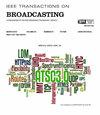用于非地面网络的计算稳定的低采样率数字预失真
IF 3.2
1区 计算机科学
Q2 ENGINEERING, ELECTRICAL & ELECTRONIC
引用次数: 0
摘要
随着第五代(5G)新无线电(NR)技术的出现,非地面网络(NTN)脱颖而出,成为实现广播卫星更广泛覆盖的解决方案。NTN 系统需要更高的数据传输速率和带宽。数字预失真(DPD)被普遍采用,是提高广播卫星 NTN 系统功率效率的有效方法。随着信号带宽的不断增加,需要降低反馈回路的带宽和模数转换器(ADC)的采样率,以降低系统成本。随着反馈带宽的减小,现有带限 DPD(BLDPD)方法的计算复杂度和过拟合效果都会提高。针对这一问题,本文提出了一种深度神经网络(DNN)辅助带限多项式数字预失真(DNN-BLP DPD)。该方法通过将少量带限基函数分组进行在线参数识别,同时在参数识别模块中嵌入 DNN,从而降低了计算复杂度和带限基函数的过拟合效应。实验结果表明,与传统的 BLDPD 相比,所提出的方法在保证建模精度的同时,还能实现较低的采样率和较低的计算复杂度。本文章由计算机程序翻译,如有差异,请以英文原文为准。
Computationally Stable Low Sampling Rate Digital Predistortion for Non-Terrestrial Networks
With the advent of the fifth generation (5G) New Radio (NR), the Non-Terrestrial Network (NTN) stands out as a solution to enable wider coverage of broadcast satellites. NTN systems require higher data rates and bandwidth. Digital predistortion (DPD) is commonly adopted as an effective method to enhance the power efficiency of broadcast satellites’ NTN systems. With the continuous increase of signal bandwidth, the bandwidth of the feedback loop and the sampling rate of analog-to-digital converters (ADCs) need to be reduced so as to reduce the system cost. The computational complexity and overfitting effect of the existing band-limited DPD (BLDPD) method will raise as the decrease of feedback bandwidth. To address this issue, one deep neural network (DNN) assisted band-limited polynomial digital predistortion (DNN-BLP DPD) is proposed in this paper. This method reduces the computational complexity and the overfitting effect of the band-limited basis functions by grouping a small number of band-limited basis functions for online parameter identification while embedding the DNN in the parameter identification module. Compared with the conventional BLDPD, the experimental results show that the proposed method can achieve a low sampling rate and low computational complexity while ensuring modeling accuracy.
求助全文
通过发布文献求助,成功后即可免费获取论文全文。
去求助
来源期刊

IEEE Transactions on Broadcasting
工程技术-电信学
CiteScore
9.40
自引率
31.10%
发文量
79
审稿时长
6-12 weeks
期刊介绍:
The Society’s Field of Interest is “Devices, equipment, techniques and systems related to broadcast technology, including the production, distribution, transmission, and propagation aspects.” In addition to this formal FOI statement, which is used to provide guidance to the Publications Committee in the selection of content, the AdCom has further resolved that “broadcast systems includes all aspects of transmission, propagation, and reception.”
 求助内容:
求助内容: 应助结果提醒方式:
应助结果提醒方式:


